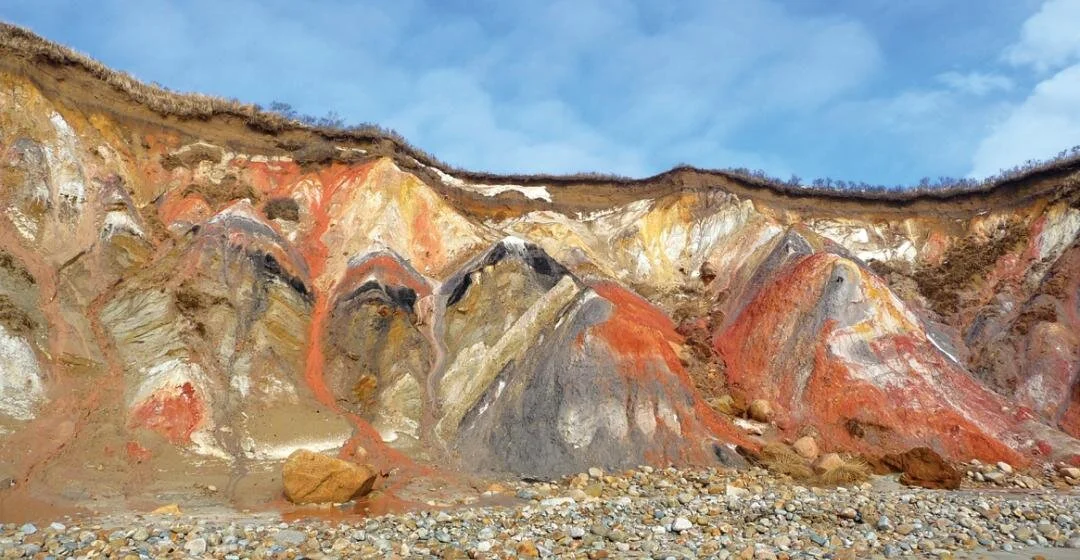Maushop's Dinner Table: Indigenous Ceramic Traditions in Southern New England
Hello and Welcome to the Belongings Blog! My name is Haley Johnson and I am a Mashpee Wampanoag Ceramicist. I have a BFA in Ceramics from Rhode Island College, an ever-growing love for art history, and as an Education Intern at the Tomaquag Museum, I am dedicated to teaching about the past and advocating for the future of Indigenous arts and artists.
Traditional Indigenous ceramics take many forms and vary from region to region. The Northeast is unique in its ceramic practices as can be seen in the color and textures of the clay, the shapes of our vessels, and the patterns and designs on finished work.
Glacial movements that formed New England left deposits of clay strewn throughout the area and are most commonly found around bodies of water. The natural clays that come from the Northeast are rich in minerals and sediments that lend to its bright oranges and deep reds upon firing. These colors then become signifiers of where the clay, and by extension, the vessel is from. For example, the cliffs of Aquinnah are harvested for clay by the Wampanoag who reside there and those pots then show a resemblance to the landscape. The clay that comes from these cliffs varies in texture and color giving artists a varied pallet from which to make their work.
The Aquinnah Wampanoag have a story that has been passed down through generations to explain the colors of the cliffs. Maushop, creator of Noepe, or Martha’s Vineyard, loved to hunt whales. Whales were the giant being’s favorite food, and while hunting, he would pluck the whales from the ocean and throw them against the cliffs to kill them, the blood spilt stained the cliffs red. As he was cooking the whale over his fire, built from only the largest trees on the island, the ashes and soot smudged the dunes with blacks and greys. Lastly, If you go to the cliffs, bleached white bones, fossilized teeth, and petrified shells scatter the shore, only providing more proof that one is walking across Maushop’s dinner table.
Photograph by Jane McTeigue
The shapes of pots and their uses also differ across Turtle Island and vary through time. Common shapes might include the small mouthed, spherical seed pots, made specifically to store seeds for sowing; or the two spouted pitcher, used in marriage ceremonies in some western tribal communities. Traditionally in the coastal Northeast, cone shaped bottoms and wide mouths indicate cooking vessels. These pieces were designed specifically to heat food like soups and stews evenly. Ramona Peters (Mashpee Wampanoag) is a contemporary potter who creates with a similar shape language. One difference in her work from historical works is the flattened bottoms. She makes the bottom of her vessels flat so that they are more easily displayed. If her pieces were made for function however, they would come to a point so that they could be more easily nestled into hot coals. Other than that, her work is very similar to the pots of our ancestors right down to the designs and patterns found on them.
Ramona Peters, All Four Points
Peters doesn’t use ceramic glazes on her work which allows the iron in her clay to show through. Glazing is a practice that usually requires more heat than a traditional pit fire can provide. Therefore, our pots rely on pigments mixed with clay for color and a matte finish. This is not to say that there isn’t a way to make this pottery shine. Burnishing and polishing with stone was a popular way to smooth and finish a piece. The process is lengthy and involves a great amount of patience and strength. The stones used are rounded and smooth and by rubbing the stone against the side of the fired pot in a circular motion, the ceramic is eroded down until it gains a nice sheen.
Pottery adornment is also popular amongst Native ceramicists. By dragging and pressing tools into wet clay, patterns similar to those seen on Southern New England woven splint basketry can be made. Peters does this in her work as seen above. The patterns made are usually representative of a story or a statement. A design is as personal to the pot as it is to the artist who makes it. Every ceramicist has their trademarks.
It should also be known that pottery is not just confined to vessels. Indigenous peoples use clay to sculpt beads, make paint, and to create sculptures. While these objects were born from necessity, they have grown to be revered in fine arts spaces, personal collections, and museum spaces. Overall, the resilience of Indigenous ceramics is paralleled by the resilience of those who make it.


